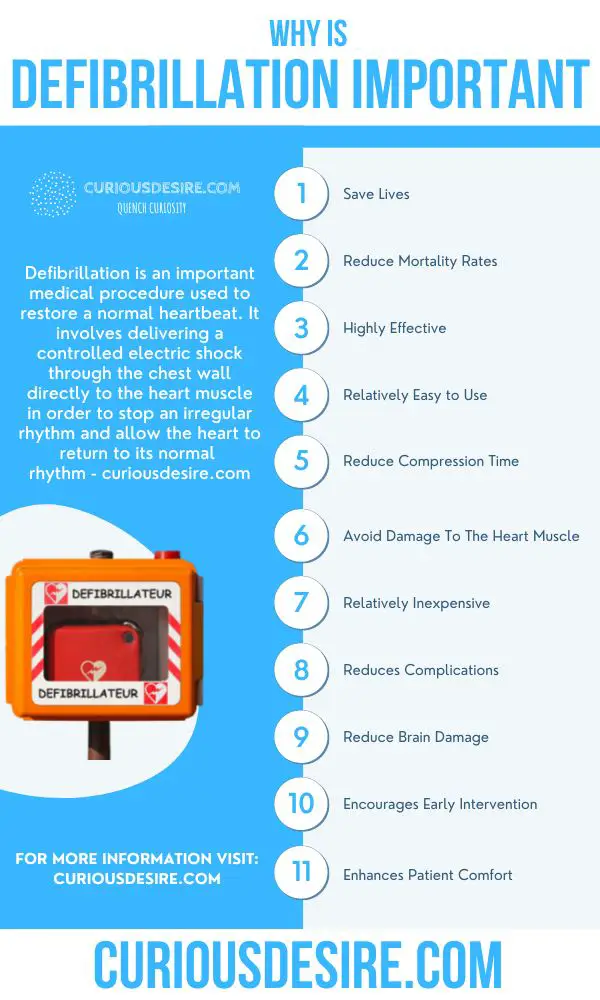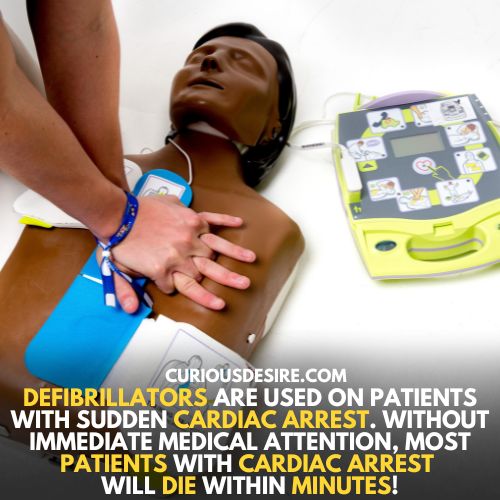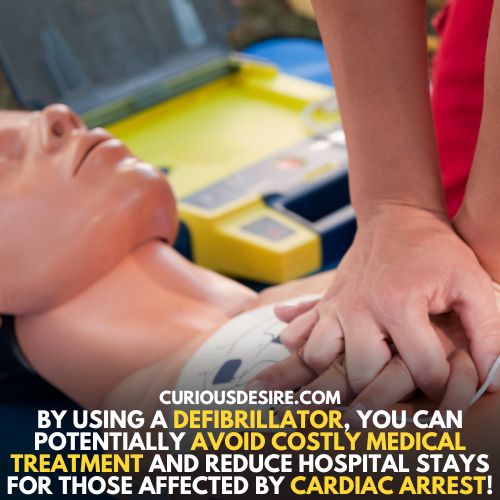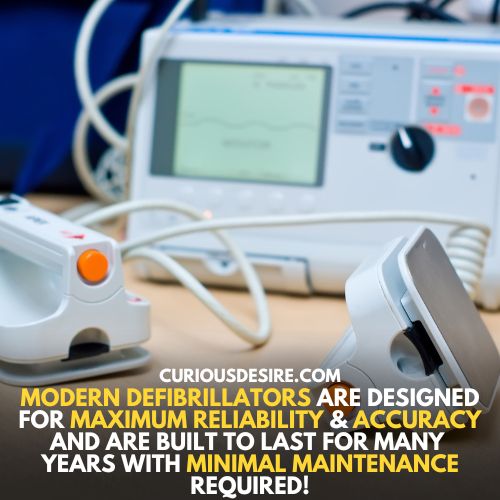Defibrillation is an important medical procedure used to restore a normal heartbeat. It involves delivering a controlled electric shock through the chest wall directly to the heart muscle in order to stop an irregular rhythm and allow the heart to return to its normal rhythm.
The use of defibrillators has become increasingly commonplace due to their importance in treating individuals who experience cardiac arrest.
In this article, we’ll discuss 15 reasons why is defibrillation important.
15 Benefits of Defibrillation and Why is it so Important
Defibrillation is a critical medical procedure that can save lives in situations when a person’s heart stops beating. It has many benefits, including:
1. Defibrillation Save Lives
Defibrillation is the only way to restart a stopped heart, and therefore, it can potentially save lives in emergency situations where time is of the essence. Defibrillators are used on patients with sudden cardiac arrest, which happens when there is an interruption in the electrical system of the heart that causes it to stop beating suddenly.

Without immediate medical attention, most patients with cardiac arrest will die within minutes. This is why defibrillation is so important; it can be used to quickly restore the heart’s normal rhythm and potentially save lives.

2. Early Defibrillation Can Reduce Mortality Rates
Early defibrillation is critical in order to restore normal heart rhythm and minimize the long-term effects of an abnormal heart rhythm. Studies have shown that early defibrillation can reduce mortality rates by up to 40%.
It can also reduce the risk of permanent brain damage and other long-term complications. Defibrillators can be used both in the emergency room and out in the community, allowing for quick action when it is needed most.
3. Defibrillation is Highly Effective
Defibrillation is a highly effective procedure with an 85-90% success rate when used on patients who have just gone into cardiac arrest.
Furthermore, if the shock is delivered within the first few minutes after an attack, it can reduce mortality rates significantly. Through this procedure, the heart can be quickly returned to its normal rhythm and functioning.
4. Defibrillators are Relatively Easy to Use
Modern defibrillators are designed to be easy and intuitive to use. Most devices have clear instructions printed on them that guide the user step-by-step through the process of using the machine correctly. This increases the likelihood that someone will be able to act quickly and use a defibrillator when it’s needed most.
By utilizing an automated external defibrillator (AED) in the event of a cardiac arrest, the patient’s chance of survival can be greatly increased. Early intervention is key to successful treatment and increases the chances of a full recovery.
5. It Can Help Reduce Compression Time
Compressions are an important part of CPR and should be performed until an ambulance or medical personnel arrive. However, if a defibrillator is available, it can be used to administer a shock as soon as possible, thus reducing the amount of time needed to perform compressions.
When used correctly, defibrillation can significantly reduce response time when dealing with a medical emergency. This is particularly important in cases where quick action is required to save someone’s life.
6. It Can Help Avoid Damage To The Heart Muscle
When administered correctly, defibrillation can help avoid long-term damage to the heart muscle. Defibrillators are designed to deliver a controlled electric shock that is strong enough to stop the irregular rhythm but not so strong as to cause further damage to the heart tissue.
It can also reduce the risk of other complications such as stroke, organ damage, and even death. Through its effective and efficient use, defibrillation can help preserve the heart muscle and improve a patient’s long-term prognosis.
7. Defibrillators Are Relatively Inexpensive
Despite their critical importance in saving lives, defibrillators are relatively inexpensive compared to other medical devices. This makes them accessible to more people and ensures that they are available in a wide range of settings.
Having access to a defibrillator can save you money in the long run. By using a defibrillator, you can potentially avoid costly medical treatment and reduce hospital stays for those affected by cardiac arrest.

8. Defibrillation Reduces Complications
A defibrillation is a vital tool for medical professionals to have in their arsenal, as it can drastically reduce the risk of complications associated with cardiac arrest.
When used correctly, defibrillation has been shown to significantly reduce the risk of brain damage, heart failure, and other life-threatening health problems. This is because a shock from a defibrillator helps to restore the heart’s normal rhythm, allowing it to pump blood more efficiently and reduce the risk of complications.
The use of defibrillation can make a significant difference in the outcome of a cardiac arrest patient. It is an essential tool in any medical professional’s arsenal and should be used whenever possible to help save lives.
9. It Can Help Reduce Brain Damage
When a person experiences cardiac arrest, the lack of oxygen to the brain can cause permanent damage if not treated quickly. Defibrillation helps to restore a normal heart rhythm, which reduces the risk of brain damage due to a lack of oxygen.
Defibrillation is a critical medical device that can help save lives in the event of cardiac arrest. The process involves sending an electric shock to the heart, which helps to restore its normal rhythm and functioning.
This allows the heart to pump blood more efficiently, reducing the risk of complications such as stroke, organ damage, and even death. It can also help reduce the risk of brain damage, as it helps to restore oxygen flow to the brain.
10. Defibrillators Are Reliable Devices
Defibrillators are highly reliable devices that can be used with confidence when needed. They are designed to provide consistent and accurate results with minimal maintenance required. This helps ensure that the device is ready and available for use with a high degree of reliability and accuracy.
Modern defibrillators are designed for maximum reliability and accuracy and are built to last for many years with minimal maintenance required.
The defibrillators are constructed from robust materials that can handle intensive use and are designed to last for many years. This means that they can provide a reliable and effective medical device when needed, helping to ensure the best possible outcome in any medical situation.

11. It Encourages Early Intervention
The presence of a defibrillator encourages early intervention in emergency situations, which can make all the difference between life and death.
Having at least one defibrillator available in public or private settings, it ensures that help is just moments away. This can be the difference between life and death in an emergency situation, as early intervention with a defibrillator can help restore a normal heart rhythm and reduce the risk of permanent brain damage due to lack of oxygen.
Defibrillation Is A Key Part Of Cardiopulmonary Resuscitation. Cardiopulmonary resuscitation (CPR) is a life-saving technique used in emergency situations where someone has experienced cardiac arrest.
12. Defibrillators are Portable
Defibrillators are designed to be easily portable, allowing them to be brought quickly and conveniently to any location. This is especially important in emergency situations, as it increases the chances of providing the vital treatment needed to save a life.
Portable defibrillators can come in a variety of sizes, ranging from small hand-held devices that can fit in a pocket to larger machines that can be wheeled on a trolley. This ensures that they are accessible and available whenever and wherever needed.
A defibrillation is an invaluable tool for saving lives in emergency situations, which is why it is so important. By having access to a defibrillator, you can help ensure that your loved ones are prepared in the event of an emergency.
13. Enhances Patient Comfort
Defibrillation can help improve the comfort of a patient by reducing pain, discomfort and anxiety associated with cardiac arrest. It can also reduce the likelihood of complications and long-term adverse effects related to cardiac arrest.
Additionally, defibrillation may provide psychological peace of mind by allowing patients to have a greater sense of control over their own health.
14. It Avoids the Need for Surgery
Defibrillation is a non-invasive procedure that does not require any type of surgical intervention or anaesthesia. Defibrillation is a safe and effective way to provide life-saving treatment without the risks associated with surgery.
It is a relatively simple procedure that requires minimal equipment, training and time, making it an invaluable tool in the management of cardiac arrest. Defibrillation has been shown to significantly increase survival rates and reduce post-cardiac arrest complications.
15. Defibrillation Facilitates Early Detection
The use of defibrillators in medical settings allows for the early detection of cardiac arrhythmias, allowing for prompt treatment and improved outcomes.
Defibrillation devices are particularly helpful in detecting cardiac events that may otherwise go unnoticed.
These devices provide medical professionals with an essential tool for detecting and treating life-threatening arrhythmias, such as ventricular fibrillation and tachycardia before they become more severe or potentially fatal.
By utilizing this life-saving technology, you can give yourself and those around you peace of mind knowing that help is just a shock away.
Conclusion
Defibrillation is a key technology in saving lives during cardiac arrest. By using a defibrillator, medical professionals can restore the heart’s normal rhythm and reduce the risk of complications. Additionally, defibrillators are relatively inexpensive, reliable and portable devices that encourage early intervention when needed.
For these reasons, having access to a defibrillator can be a life-saving tool in emergency situations. Therefore, it is essential for all public and private settings to have at least one defibrillator available for use. By doing so, we can provide the best chance of giving someone in need an opportunity to live.